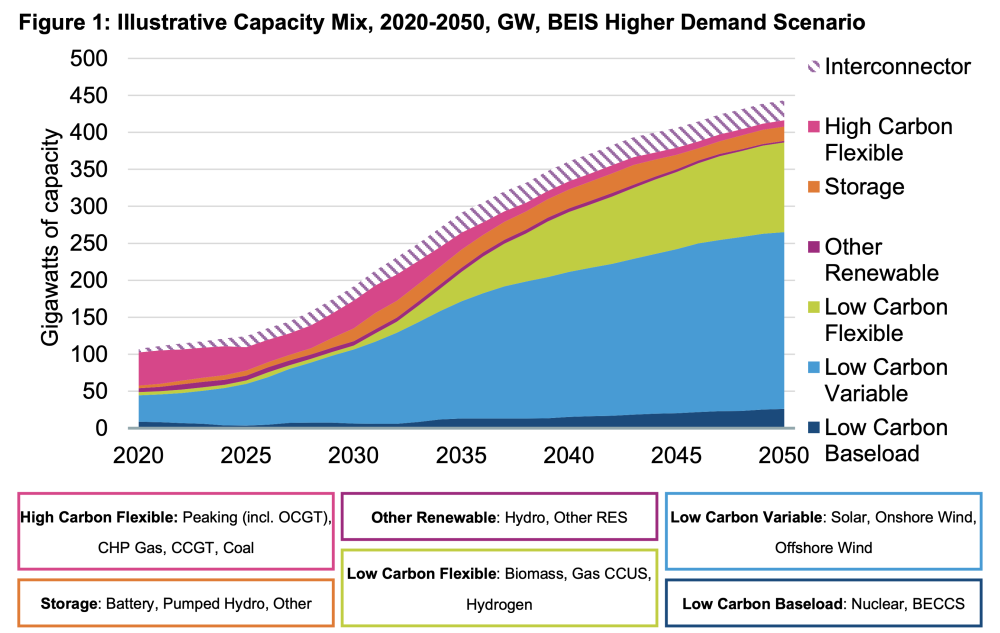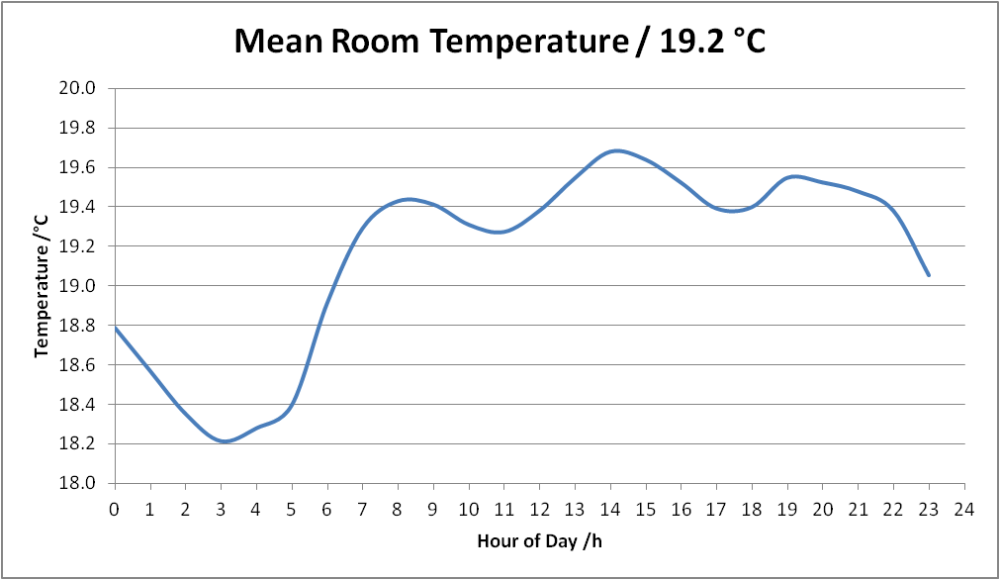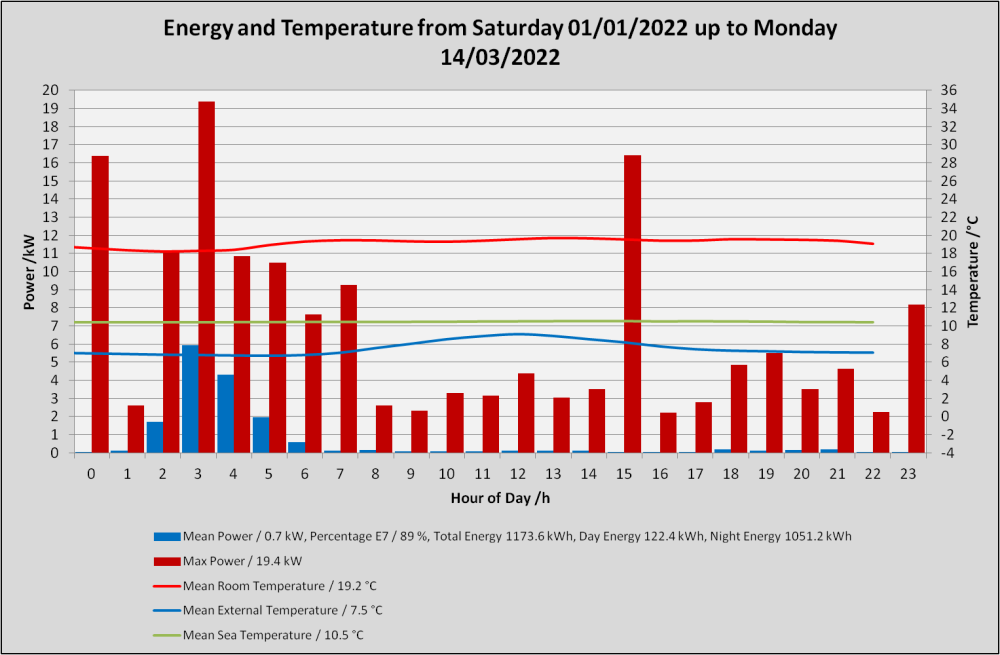Leaderboard
Popular Content
Showing content with the highest reputation on 09/05/22 in all areas
-
All they need do is delink the gas price from nuclear and renewables. At the moment the wholesale price of electricity is all based on gas generated electric. Why should the tax payer support extra profits for generators where it costs no more to generate than it did prior to the gas price rise.5 points
-
If you paid for the renewable and nuclear at the "correct" rates (cost plus reasonable profit) and only paid for the gas derived electricity at a higher rate, then you would have a wholesale electricity rate of the average of all those, depending how much of each you generate. I guess your question translates to, well if we have been sensible and decoupled our pricing, but the rest of the world has not, then they would all want to buy as much as they can of our "cheap" electricity to the capacity of the interconnectors. Or would they see the light and decouple their prices as well?2 points
-
Just thought I’d share this As it may help others on here I run a medium sized render company and was asked to quote for a friend of a friend A self build in the lake district About 50 miles away I said sure send me a drawing Most of our framing plastering jobs are off plan to allow the builders to use our quote within there quote Anyway The self builder has asked me to re quote from six months ago As two Sole traders have quoted more than 50% higher than ours Stating 4 weeks work There’s only 225m2 5 days tops I’d allowed 8 rise in materials on the initial quote and charged a bit extra on labour with it being a small job We give a three year no quibble guarantee If there is a problem and it’s a manufacturer based problem We sort it out and Pursue the manufacture At the moment individual trades are taking the mick I hear about tilers charging nearly £50 m2 for floor tiling I pay ours around 18-22 and they make a dam good living out of that Private builders and trades are giving everyone a bad name Shop around for an experienced company You will have to wait But it’s worth the wait2 points
-
Thats around £5 per m2 cheaper than what I've been quoted at £29 m2. It's probably a combination of distance from the cement supplier to my site being further away as a local ones stopped providing it, and possibly reduced load compared to you, 8m3 vs my 4.5m31 point
-
1 point
-
Have a read of this thread Some models have an issue with a crankcase heater permanently on that increases the power consumption.1 point
-
There may be a few issues Reducing flow temp to hot water cylinder will increase CoP, store water at a lower temp. Slowly over a couple of days reduce the temperature until the last use of the day starts to go cold, then add a couple of degrees. Cold rooms in the house increase the heat loss in warm rooms as they are experiencing heat loss external and internal. So the heat pump has to run harder to make up the difference. Also you end up making the heating circuit smaller so the heat pump cannot flow at a high enough rate, so suffers frequent shutdowns or short cycles. Both are no good for the CoP. Go on to heat geek and read up on how to balance your heating system. You really want the system to have an open system to flow against, but set the flow rates to get the temperature you want. The thermostat then are set higher than you need and operate as limit stops only, not as temperature controllers. You then need to get your heating flow temperature as low as you can, do the same as the DHW reduce over a period of days, then when it's not heating as you want it bring back a degree or so Can you set up weather compensation? Again have a read on heat geek site.1 point
-
Sorry lots of comments as I think your being taken for an expensive ride. I would say the scheme way to complicated for its own good and your sanity. The boiler only ramps down to 7.1kW if you have only a couple zones operating your boiler will be shutting down and starting up like no tomorrow, using lots of gas and provide little or no heat. You need to make sure all the pumps are hydraulically separated, a series of close coupled tees will do. You may need to look at the return flows also. First thing is dump all/most the room stats, they will just cause the boiler to short cycle and use loads of excess gas. Also operating as one or at most two zones will let you remove the motorised isolation valve from upstream of each manifold. The pump will pull the water through as needed. I would dump all the smart stuff and use a single glowworm controller in a central location and outside temperature sensor and enable weather compensation. Then balance the room flows to get the temperature you require. You don't need UFH in the halls or landings, they will get heat from the pipes going to rooms and borrow ambient heat from everywhere. We have UFH in the bedrooms and I would say to anyone don't do it. Way to slow respond, radiators or fan coil, then at least you can implement cooling later when you have a heat pump.1 point
-
Was 10p/kWh in the early 1990s. A small EU made car was 7k then, about 15k now. A pint was 1.50, now 4. A basic desktop PC 1500, now about 350. My neighbours house was in Aylesbury, 38k now and over 250k. Bank rate about 8% now 2%. Very hard to compare prices we all have different spending patterns and priorities. Why would you pump it. Making on sight would be easier.1 point
-
If you build renewables in the UK you will get a decent return on investment. No need for government investment, after all they are already almost 50% of generation without the government having to invest in them. Nuclear is where risks and costs are higher so governments probably need to be involved. The issue is, something we are all well aware of here, the difficulty in getting permission to build them. I did a project on this at work and it looks like we need something like a five fold increase in wind capacity over the next 20 years in the UK, I think the global figure was about ten fold. Pre Ukraine, however, you wouldn't just build lots of unneeded wind capacity, it would be built over time in line with increasing demand and the need to reduce emissions. This is what is expected if you look at the energy policy document I posted earlier. All the capacity increases come from low carbon sources (wind and solar for the next 10 years with some hydrogen kicking in after that). The work I did suggested that for some time we can reduce emissions with wind and solar but eventually you would need to use hydrogen in cases where electricity cannot be used - think boilers for stately homes and mining trucks. The expectation is that at some point in the future there will be so much cheap renewable energy that we can them use that to make hydrogen to get the last part of the ay to net zero. The most surprising thing that I found is that the price of electricity was expected to fall over time making the inefficient process of making hydrogen more attractive. Personally I felt this was a stretch but that is the industry forecast. In a way Putin has made seen this coming, if you look at the percentage of electricity coming from gas it drops dramatically from 2025 onwards. The high growth in electricity demand is partly driven by an assumption that we move over to heat pumps for most heating over the next 20 years. I expect hat when our boiler gives up the ghost I will replace it with an ASHP.1 point
-
With what though? Where is the money going to come from in the next handful of years given how deep in the hole we already are with energy, the NHS, etc (etc, etc, etc)? It's the apocryphal story of asking the farmer for directions and being told "Well I wouldn't start from here". Imagine if we'd spent all the HS2 money, and 90% of the track and trace + PPE scandal money on renewables?1 point
-
I agonised over the same issue. In the end I was too stubborn to pay more for a window just for the benefit of it NOT having a trickle ventilator, I object to paying more for something not to be fitted. So standard velux and with the ventilator closed no noticable draughts and no issue on the air tightness test.1 point
-
Why not just use 20mm galvanised thick wall conduit and spray the ends with galv spray ..?1 point
-
Whilst doing some upgrade to your insulation while you are there makes sense, im not sure why anyone would ask building control either way. id just crack on and do what you need to do.1 point
-
If you can't get the length you want...You could use a short, stainless dowel screw into the timber ring beam. Then a stainless thread connector and as long a piece of stainless stud as you need coming off that.1 point
-
And as they scrape that man from the pavement, his mate kept hold of the panel, but is stuck on the roof and can't get down as he has no hand free.1 point
-
@ProDave look at Dowel Screws. They are usually galvanised steel and have a torx drive in one end and come in all sizes. You would end up with studs poking from the wall then and just use M10/12 nuts and washers on the ends.1 point
-
Half the time they produce nothing, then half of the remains time they produce less that 100W, half again, between 100W, but below 200W. So while it is true to say you get less maximum power, you probably get a lot more energy oversizing. If you store that energy, you can design to draw more power via other methods.1 point
-
We started our first build in November so made building the two garages for storage was a priority Starting in dry weather this time has made this less of a priority But really should have been done first But great to get the garage workshop covered in Myself and my wife started at 6am yesterday with storms forecast later that day Luckily they failed to materialize Which allowed us to get it watertight1 point
-
1 point
-
+1 to the above. I think the work done has stabilised it. If as we suspect the present soffits were fitted about the time of that work, then if there had been further movement you would have seen the soffits separating from the walls. I don't think you had seen any movement there which means the stabilising work has worked.1 point
-
If we are selling overseas they pay market rate for importing the energy, we also pay market rate at time of import into the UK. Just normal commercial transaction. Import and gas electric will fluctuate in price the average price would be passed on to the consumer at some point. They should be able sort that quite easily,as the system has been used for decades.1 point
-
Wow that’s comprehensive, well done. IMO it’s not going anywhere with that new purlin, new brick support and substantial timber. I think it did “spread” like I originally said but much too late to pull it back but as it’s going nowhere I don’t think it’s a problem.1 point
-
Will that be the same idiots that claim they don't work and never, ever, pay back their energy debt.1 point
-
Weve recently installed 2 x SE systems on top of the 2015 FIT system we already had. A breeze to install and very easy to add/alter if you want to expand/rearrange panels. We had an optimiser fail on the FIT system a few years ago which was easily spotted with SE module level monitoring. SE diagnosed the fault remotely and sent out a replacement within a few days... I didnt have to ask. Fitting the module is DIY if youve got access to an alloy scaffold tower(own/hire/borrow) OR a ladder and rope/harness. Remember that with an SE system youre only dealing with <40 volts on the roof. Loads of advantages with an SE system that have been detailed in previous posts👍1 point
-
Do you man the power taken to run a kettle ~2.8 kW, or the energy to boil a kettle full of water ~0.16 kWh. I had a quick look at the first 72 day of this year, daily mean of 16.3 kWh, then looked at the 72 days from June 1st, 3.1 kWh. So 3.1 kWh/day for DHW and everything else (ish). So to heat my 48 m2 house takes, on average 13.2 kWh/day. 72 days is 2448 hours [950.4 kWh] works out at a mean power of 423 W, or 9W/m2. The mean room temperature was 19.2°C, mean external temperature 7.5°C, a delta of 11.7°C. The mean room temperature is a little lower than I aim for [20°C], but the hourly profile is pretty good now [delaying the start of heating helps]. With my new draught proofing measure this year, I expect to see a reduction in usage and an increase in temperature to close to the target. Below is a more detailed profile.1 point
-
We had several lots of £300 compensation over the incompetence of BT and Openreach. The first thing that happened, when I asked BT to connect the new property up with a line, was that they cut off our existing house line. This was just days after husband's cancer diagnosis leaving us completely incommunicado as the mobile signal is cr*p. After frantic rushing around waving said mobile in the air in pouring rain I managed to get a manager on the phone. This, I believe was due to us having fibre to the premises and that department being properly staffed. From then on it took a year of frequent phone calls and messages to get the new build connected. I found Facebook messaging them to be very effective. Not only do you get a human to plead with, but you have an easily readable dialogue for the next operator to read! In our case it was like a Greek tragedy and they were all truly horrified at what we had been through! Good Luck! Oh, and don't let them "cancel the complaint" when they make you a promise of action.1 point
-
In what way? I have a layer of insulation between floor & screed. Don't most people?1 point
-
We used Cameron Ross, they seem to cover most of Scotland. Worth a call. Our architect did out percolation test. You may need a small digger on site for digging the holes required.1 point
-
You have two separate things there, I have edited the title. A SE would do the the drainage design, you need a company that does site investigations for the percolation test and site investigation. The SE might be able to recommend one. I will PM you a company I have used for site investigation and percolation tests. It will cost the best part of £4k.1 point
-
1 point
-
I also did my own also, did the trays, pre ran all the cables in conduit, mounted isolation switches, inverter, electoral guy did the rest and signed the G98 form. Mine is 3.1kW, just over £2.5k for everything. Electrical costs lost in the new house wiring costs. I think only the battery can go into island mode, PV cannot, not sure how legitimate be artery islanding is within G98/99 rules. Not sure of the maths of batteries yet. I self consume everything the PV gives me, via a diverter to heat hot water. Battery no use to me.1 point
-
@LinearPancakesI’m embarrassed to admit they I still have not got around to buying one! So still deliberating…. I have been impressed in the current hot weather by how cool that house has been, one of the benefits appears that mvhr might negate the issue of mosquitos entering via open windows at night. Oh and that I need it to get building regs sign off1 point
-
And if it's not making a noise? Until you open the box you won't know whether it's dead or alive...or even if there's a cat in there...1 point
-
0 points
-
0 points
-
Well I lost a chisel in my brothers wall cavity when working on it in the 70,s, could not believe my luck when I found it again in the 00,s when breaking into the cavity at floor level doing other work 👀0 points
-
So we'll at least have the lights on, to see what's not on our plates!0 points
-
Listening to the news this morning, there was some German energy person on. He was saying that they (the Germans) need to find a German solution to the energy crisis. Will that be another Final Solution for them. While I was pondering all this, another bit came on about how, if we had done the suggestions mooted at the beginning of the 'crisis', they would have been wrong and inadequate. I agree with this. Then I thought more, and wondered if we do not bail out the energy retailers (as opposed to the producers), should we give discounts to individual users, similar to what we are currently doing. Then I thought even more. If you get RHI, FiTs or had a grant to fit RE kit, should you be getting any help. You have been claiming 'help' already, sometimes quite a lot. Then, after more thinking, I realised that is way to hard to manage it all, so went back to my original idea mentioned it on here somewhere some weeks ago, that we just need to support the energy retailers. Then a bit more thinking, to what extent do we need to support them. The long term, auction mean price of electricity has been around £50/MWh. So why not set the price cap at £75/MWh that retailers can pay, then the Treasury chips in the difference, which some days may be £100/MWH, other days nothing. The records are there, accounts and bookkeepers like doing that sort of stuff, and the end users (us) have manageable bills, all be it higher than they were. A secondary advantage is that it should encourage investment in RE. I would include nuclear in that, but they cannot buy a £1 sandwich from Poundland without it costing a million quid, and by the time they got the sandwich it would be a decade old and more mouldy that a British Rail one. Then I thought my 2 minute shower was over and I better get out, don't want to waste energy. No one can see your tears of pain as hot shower water goes down the plug hole.0 points
-
Not sure what I mean, I just recall @Gone West quoting a figure that was semi understandable / relatable to a thicko like me! It was impressive whatever it was. There's a discussion on another forum where the whole passive concept is taking a bit of a knocking by some who clearly don't understand. Just figured I'd chip in with something real world relatable. Quite funny really, comments like "Our friends have a passive House, it looks horrible". Then "You won't get permission to build one in the UK". As an aside there's gems on the lines of "The UK doesn't get enough sun for solar power". I just wish I was uneducated to the concept. Ignorance is bliss as they say.0 points
-
Chamberlain. Had it about 10 years...only just taken out of the box! 😂 Fired it up for the first time last night via a temporary lead. Double checked the wiring beforehand of course. Need to sleeve a grey core with some blue sometime but it's all got cable markers etc. Both CR2032 batteries in the remotes dead of course! Fitted a new one in one and it all works a treat so far, nice smooth running action. With a bit of lube it should be even better/quieter. Just got to set up the end of travel magnets tonight. Have "misplaced" one of the magnet mounting brackets like this. Tbh the space between lugs is too narrow to fit over the metal rack I have (like 20mm vs 22mm), designed I guess for the plastic rack: Gave to laddo and a few minutes later: He'll print a couple in black PETG and I'll affix with M5 stainless, countersunk screws drilled and tapped into the rack. Though I've buried ducted SWA from the garage to gate pillar it's justy coiled up inside the garage along with a couple of other comms cables for video entry, camera etc. That's the next mission, thread it round the garage but I need to move h.duty shelves and one car, possibly two! Then trench to the house... So another 10 years! 🤣0 points
-
0 points




.jpg.c21f3ac78c9b7efd90cbdcb312744dc5.thumb.jpg.7adcad4c0e384f5ecd7d56b0618df6e5.jpg)








